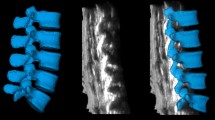Summary
Background. The prototype of a 3D ultrasound navigation system, with a trackable 4- to 8-MHz phased-array ultrasound probe was used in syrinx-surgery. The aim of this study was to evaluate the advantages offered by 3D ultrasound and navigation in syringomyelial surgery.
Methods and materials. After laminectomy, with a free-handed tilt of the ultrasound probe, the 3D volume of the target area is acquired within 15 seconds. The data are visualized after reconstruction in an axial, coronal, and sagittal view, offering the possibility of ultrasound-based guided surgery.
Results. Based on the intraoperative volume information, it was possible to navigate with the 3D ultrasound images in all cases. The orientation and image quality with respect to resolution, spatial information, and the identification of anatomical structures facilitated the surgery in all seven cases.
The navigation tool, with a length of 12 cm and a tip diameter of 1 mm, was simple to place into the surgical site. The availability of an up-to-date 3D-image resulted in less interruption of the surgical procedure, with no need to repeatedly fill the cavity with sterile saline for new ultrasound acquisitions. New ultrasound images were only required if shift occurred.
The coronal and “trajectory-plane” views, offer additional information about the syrinx cavity. The target borders are easier to determine and orientation in separated cavities was possible. Particularly in syringomyelial surgery it was helpful to determine the surface point of the syrinx to place the myelotomy or insert a catheter.
Conclusion. 3D ultrasound offers the advantages of visualizing the third dimension of the target. For orientation and border determination navigation within the 3D ultrasound volume is very helpful and can take place with the ultrasound probe out of the way. Any disruption in the surgical procedure is minimized by not having to repeatedly fill the cavity with a sterile saline solution, there are fewer difficulties with image orientation because of new image adjustments.
Similar content being viewed by others
Author information
Authors and Affiliations
Rights and permissions
About this article
Cite this article
Bonsanto, M., Metzner, R., Aschoff, A. et al. 3D ultrasound navigation in syrinx surgery – a feasibility study. Acta Neurochir (Wien) 147, 533–541 (2005). https://doi.org/10.1007/s00701-005-0505-7
Received:
Accepted:
Published:
Issue Date:
DOI: https://doi.org/10.1007/s00701-005-0505-7




